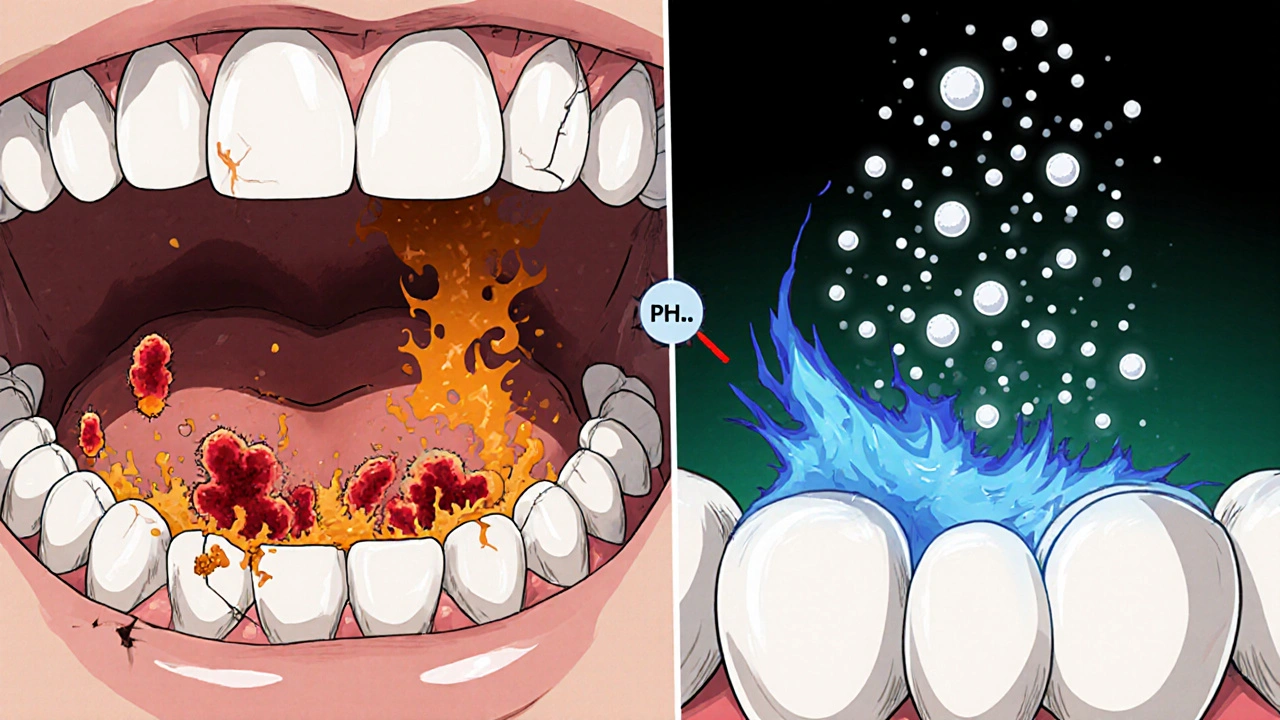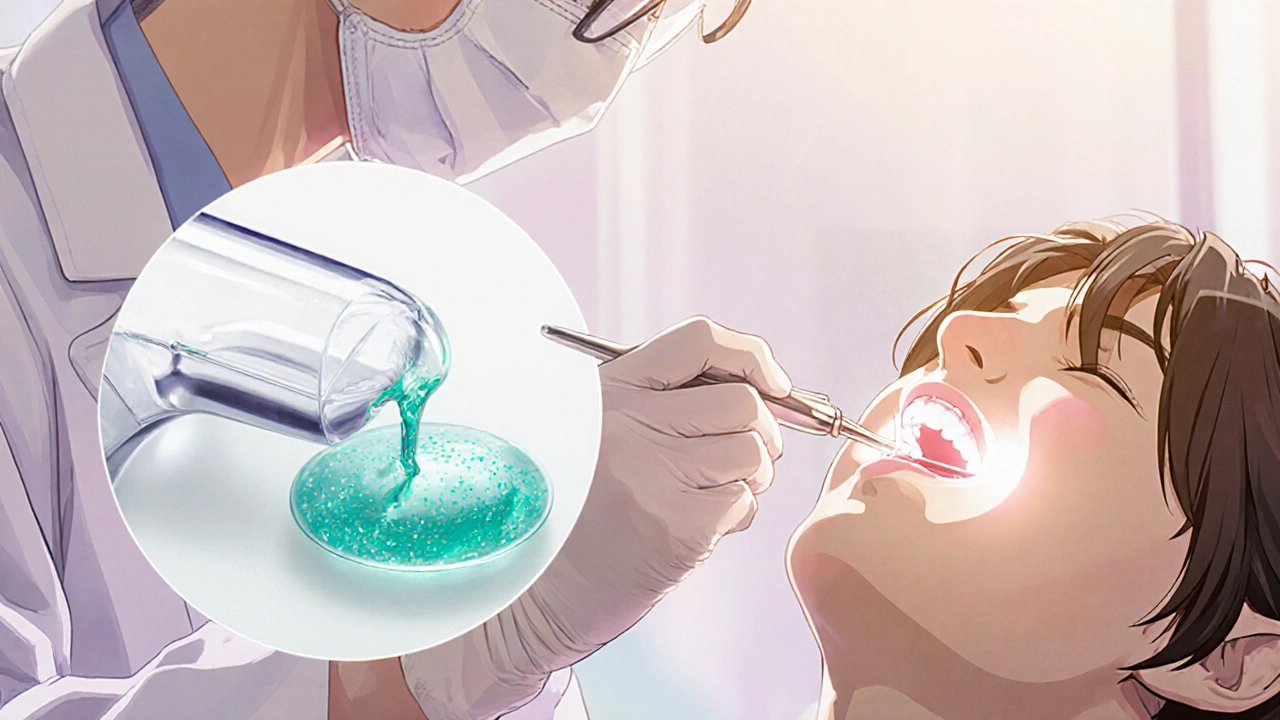Oral pH Balance Calculator
How Your Diet Affects Your Oral pH
Enter your daily consumption habits to see how they affect your mouth's pH balance. Magnesium hydroxide can help neutralize acids and maintain a healthy oral environment.
Your Oral pH Balance Assessment
Estimated pH level:
Key Takeaways
- Magnesium hydroxide raises oral pH, protecting enamel from acid erosion.
- It gently neutralizes plaque‑producing acids without the harshness of some oral rinses.
- When added to toothpaste or mouthwash, it works alongside fluoride for stronger protection.
- Side effects are rare, but over‑use can alter taste or cause mild irritation.
- Choosing the right formulation (paste, rinse, professional gel) matters for best results.
When you think about a brighter smile, the first thing that comes to mind is often fluoride. magnesium hydroxide is a white, slightly bitter mineral that has been used for decades as an antacid and laxative. In the last few years dental researchers started looking at its ability to balance mouth pH and soften plaque. The key player here is magnesium hydroxide. This article walks through how it works, where you can find it, and what you should watch out for.
What is magnesium hydroxide?
Magnesium hydroxide is a basic (alkaline) compound with the chemical formula Mg(OH)₂. In water it slowly releases hydroxide ions, raising the pH of the solution. Because it does so gently, the mineral is considered safe for short‑term oral exposure. The same laxative you might have seen on a pharmacy shelf is called “milk of magnesia,” a suspension of this compound in water.
How does oral pH affect dental health?
Every bite of sugar‑filled food starts a chain reaction. Bacteria in dental plaque ferment the sugars, creating acids that drop the pH of the saliva below 5.5. Below that threshold, hydroxyapatite - the mineral that makes up tooth enamel - begins to dissolve, leading to enamel softening and eventually cavities.
Saliva normally buffers these acids, bringing the pH back up. When buffering is weak (dry mouth, high‑acid diet, certain medications), the mouth stays acidic longer, and damage accumulates.
Magnesium hydroxide as a pH neutralizer
Because magnesium hydroxide releases hydroxide ions, it pushes the oral environment toward neutral or slightly alkaline conditions (pH 7‑8). This does two things:
- It reduces the time enamel is exposed to harmful acids.
- It creates an environment where acid‑producing bacteria are less active, slowing plaque formation.
Studies from 2023 and 2024 measuring plaque pH after a magnesium hydroxide rinse showed an average increase of 1.2 pH units within five minutes, staying elevated for up to 30 minutes.

Benefits beyond pH control
While pH balancing is the headline benefit, magnesium hydroxide also offers:
- Gentle abrasive action: The fine particles help remove surface stains without the harshness of silica beads.
- Soothing effect on inflamed gingiva: The mild alkalinity can calm mild irritation caused by aggressive brushing.
- Compatibility with fluoride: It does not interfere with fluoride’s remineralization pathway, allowing both to work together.
How to incorporate magnesium hydroxide into your routine
There are three main formats you’ll see on the market:
| Form | Typical Use | Frequency |
|---|---|---|
| Toothpaste | Brush twice daily | Every day |
| Mouthwash (liquid) | Rinse for 30‑60 seconds | 1‑2 times per day |
| Professional gel (in‑office) | Applied by dentist after cleaning | Every 6‑12 months |
When choosing a product, look for a label that lists magnesium hydroxide as the active neutralizing ingredient, not just an “alkaline base.” The concentration typically ranges from 0.5% to 2% in over‑the‑counter items.
Safety profile and possible side effects
Because magnesium hydroxide is poorly absorbed through the oral mucosa, systemic toxicity is rare. The most common complaints are:
- Temporary tingling or metallic taste - usually fades after a few days.
- Mild gum irritation if you use a high‑concentration gel daily.
People with severe kidney disease should consult a doctor before using magnesium‑based oral products, as excess magnesium can accumulate.

Comparing magnesium hydroxide with other oral alkalizers
| Agent | pH Impact | Primary Benefit | Typical Use | Safety Notes |
|---|---|---|---|---|
| Magnesium hydroxide | Raises to 7‑8 | Neutralizes acids, gentle abrasive | Toothpaste, rinse, gel | Rare irritation, avoid overuse |
| Fluoride | Neutral to slightly acidic | Remineralizes enamel | Toothpaste, varnish | Excess can cause fluorosis |
| Sodium bicarbonate | Raises to 8‑9 | Strong abrasive, deodorizes | Powdered toothpaste, DIY rinse | Can wear enamel if used aggressively |
The table shows why many dentists recommend using magnesium hydroxide alongside fluoride: you get the protective enamel boost from fluoride while magnesium hydroxide keeps the mouth’s pH in check.
Practical tips for getting the most out of magnesium hydroxide
- Use a magnesium‑hydroxide toothpaste as your daily brush, but follow up with a fluoride rinse if you’re prone to cavities.
- After meals high in sugar or acidic drinks, swish with a diluted magnesium hydroxide mouthwash (1 tsp in 8 oz water) to bring pH back up quickly.
- Don’t replace your regular fluoride treatments entirely; think of magnesium hydroxide as a pH guard, not a remineralizer.
- If you have dry mouth, combine magnesium hydroxide with saliva‑stimulating gum to maintain a balanced environment.
- Store liquid rinses in a cool, dark place - the compound can settle over time, and shaking ensures even distribution.
Future research directions
Current clinical trials are exploring slow‑release magnesium hydroxide particles embedded in dental sealants. Early data suggest a 30% reduction in secondary caries around sealant margins over a two‑year period. Another line of work looks at combining magnesium hydroxide with probiotics that compete with acid‑producing bacteria, potentially creating a long‑lasting protective bio‑film.
Bottom line
Magnesium hydroxide isn’t a magic bullet, but it adds a useful layer of protection by keeping the mouth alkaline, whitening gently, and soothing gums. When paired with fluoride and good brushing habits, it can help you keep enamel strong and breath fresh.
Can I use magnesium hydroxide toothpaste if I already brush with fluoride?
Yes. The two work together - fluoride rebuilds mineral loss while magnesium hydroxide keeps the environment from becoming too acidic. Just follow the product instructions and don’t double‑dip with two strong alkalizers.
Will a magnesium hydroxide rinse replace my regular mouthwash?
It can supplement but not fully replace a fluoride or antibacterial mouthwash. Use the magnesium rinse after meals, and keep your regular fluoride rinse for nighttime protection.
Is magnesium hydroxide safe for children?
For kids over six, low‑concentration toothpaste (around 0.5%) is generally safe. Younger children should use fluoride‑only products unless a pediatric dentist advises otherwise.
Can over‑use cause any problems?
Using more than the recommended amount can lead to a chalky taste and mild irritation. It won’t damage enamel, but it offers no extra benefit.
How often should I get a professional magnesium hydroxide gel treatment?
Most dentists apply it after a deep cleaning, typically once a year. Your dentist can tailor the schedule based on your caries risk.

4 Comments
I've been trying out a magnesium hydroxide toothpaste for a couple of weeks and honestly, my mouth feels fresher. The mild alkaline boost seems to calm the sting after a sour snack, and I haven't noticed any extra wear on my enamel. It pairs nicely with my regular fluoride rinse, so I feel like I'm covering both bases. Keep it up, folks – a little extra pH balance can go a long way!
Magnesium hydroxide sounds fancy but it's just another gimmick. It won't replace proper brushing and flossing. The hype is overblown.
I get the appeal of a gentle alkalizer, but relying on it too much could mask poor oral habits. The article glosses over the risk of a chalky aftertaste if you overdo it. Plus, the abrasive action is minimal compared to traditional silica. Still, for those with sensitive gums, it might be a decent add‑on.
pH balance in the mouth is a subtle game it often gets ignored a little shift can protect enamel over time however we shouldn't view magnesium hydroxide as a silver bullet it works best alongside fluoride and regular hygiene
Write a comment